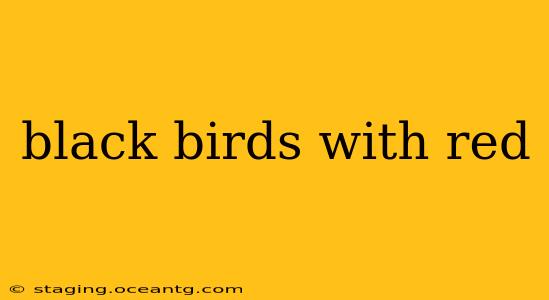The phrase "black birds with red" evokes a surprisingly diverse range of avian species. Pinpointing the exact bird requires more detail, but this guide will explore some of the most common black birds featuring red markings, helping you narrow down the possibilities. We'll delve into their identification characteristics, habitats, and behaviors, answering frequently asked questions along the way.
What are some black birds with red markings?
Many black birds incorporate red in their plumage, either as accents or more prominent features. The specific shade of red, its location on the bird, and other plumage characteristics are crucial for accurate identification. Some notable examples include:
-
Red-winged Blackbird (Agelaius phoeniceus): This is probably the most well-known bird fitting this description. Males are predominantly black with striking scarlet and yellow shoulder patches (wing bars) that are highly visible during flight. Females are a more subdued brown.
-
Northern Cardinal (Cardinalis cardinalis): While not entirely black, the male Northern Cardinal possesses a vibrant red body with black markings around the face. They are common in many parts of North America.
-
Summer Tanager (Piranga rubra): Adult males are a striking crimson red, while females are a more yellowish-olive green. They're not entirely black, but their dark wings and tail contribute to this general description.
-
Crimson-collared Grosbeak (Rhodopechys sanguineus): This Old World species features a dark body with a crimson collar. Depending on the light and distance, the black could be prominent.
-
Various subspecies of Blackbirds: Many blackbird species have regional variations exhibiting hints of red, often in the feathers of the wings or tail. These subtle differences can often only be noted upon close observation.
What kind of black bird has red on its wings?
The most likely candidate here is the Red-winged Blackbird. The bright red and yellow shoulder patches are their defining characteristic, easily visible when they are in flight or perched with their wings slightly raised. Other birds might have some red in their wings, but the Red-winged Blackbird's are particularly noticeable and significant for identification.
What black bird has a red breast?
While no completely black bird has a purely red breast, the Northern Cardinal comes closest. Males are predominantly red, with black accents on their face, making the red breast a highly distinctive feature. Remember that females are a brownish-red hue.
What black bird has a red head?
No common bird is entirely black and features a completely red head. However, some birds might show hints of red on their head depending on subspecies or light conditions. Consider comparing your observations to regional field guides for potentially less-common birds.
How can I identify a black bird with red?
Accurate identification requires careful observation of several factors:
- Location: Where did you see the bird? Geographic location significantly narrows down the possibilities.
- Size and Shape: Was the bird large or small? What was its overall shape and body proportions?
- Plumage: Note the precise shade of black and red, and their location on the bird. Consider other colors present.
- Behavior: What was the bird doing? Was it foraging, singing, or in flight?
- Habitat: Where was the bird located? Different species inhabit different environments.
Using a field guide specific to your region and referencing online bird identification resources with photographs can greatly assist. If possible, taking a clear photograph of the bird will be immensely helpful.
Conclusion:
Identifying birds accurately can be a rewarding challenge. The diverse range of black birds with red markings requires careful observation and comparison against reference materials. Remember to take your time, be attentive to detail, and utilize available resources to successfully identify the black bird you've encountered.
